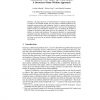Free Online Productivity Tools
i2Speak
i2Symbol
i2OCR
iTex2Img
iWeb2Print
iWeb2Shot
i2Type
iPdf2Split
iPdf2Merge
i2Bopomofo
i2Arabic
i2Style
i2Image
i2PDF
iLatex2Rtf
Sci2ools
DAGM
2005
Springer
2005
Springer
Calibration-Free Hand-Eye Calibration: A Structure-from-Motion Approach
The paper presents an extended hand-eye calibration approach that, in contrast to the standard method, does not require a calibration pattern for determining camera position and orientation. Instead, a structure-from-motion algorithm is applied for obtaining the eye-data that is necessary for computing the unknown hand-eye transformation. Different ways of extending the standard algorithm are presented, which mainly involves the estimation of a scale factor in addition to rotation and translation. The proposed methods are experimentally compared using data obtained from an optical tracking system that determines the pose of an endoscopic camera. The approach is of special interest in our clinical setup, as the usage of an unsterile calibration pattern is difficult in a sterile environment.
| Added | 26 Jun 2010 |
| Updated | 26 Jun 2010 |
| Type | Conference |
| Year | 2005 |
| Where | DAGM |
| Authors | Jochen Schmidt, Florian Vogt, Heinrich Niemann |
Comments (0)

